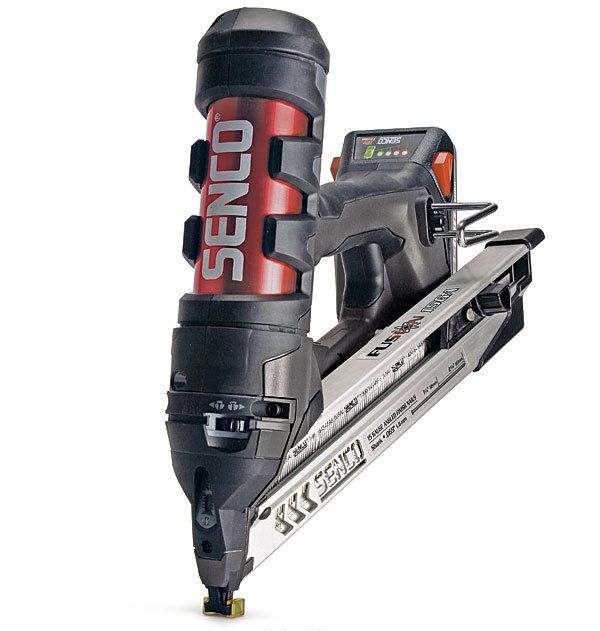Senco FN65DA 15 ga. Nitro-Fueled Nailer
The Fusion finish nailer uses a built-in cylinder of compressed nitrogen to fire nails quickly, reliably, and without hoses or cartridges.

Every time a new gas or electric hose-free nailer hits the market, I think that I will finally be able to retire my compressor-powered nailers. Some models have come close, but their bulk, weight, fumes, maintenance requirements, and electronic glitches have always sent me back to the compressor and hose. The new Senco Fusion (FN65DA; www.fusionpowertool.com), however, delivers power and speed in a lightweight package for real-world work without compromise.
The magic of this 15-ga. tool is in its guts, where advances in battery technology have been teamed up with creative engineering. At its heart, the Fusion is a pneumatic tool, but instead of using external power (air hose and compressor) or internal power (fuel cartridge or flywheel), Senco has turned the pneumatic motor itself into an onboard compressor. A Li-ion battery powers a tiny motor that retracts the firing piston after it shoots each nail. In the process, nitrogen gas in the sealed chamber is recompressed to drive the next nail. In bumpfire mode, I was able to shoot an average of 80 nails per minute without a problem, and the battery can fire up to 600 times on a single charge. That’s more than adequate for any day of trimwork I can imagine, but just in case, the tool has a second battery.
At 6 lb. 9 oz., the Fusion is lighter than DeWalt’s hose-free nailers, but heavier than the Paslode 900600 and most externally pressurized 15-ga. models. With the handle and trigger placement, though, your grip is close in on the motor, making the tool feel balanced and comfortable in use.
The three-position trigger switch lets you choose between sequential (single) and bump-fire modes. There is also an “off” setting to save battery power when the tool is not in use. This feature takes some getting used to, especially when trying to figure out why the tool refuses to work.
The depth-of-drive thumbwheel is smooth plastic, so my old dry fingers just slide on it; a soft-plastic wheel would solve that problem. The tool does have a helpful indicator that shows where in the range of depths you’ve set the wheel—no more spinning the thumbwheel after it has maxed out at the top or bottom of the range.
As with many 15-ga. trim nailers, racks of nails load through the rear of the magazine, which also detaches with the quick flip of a lever located near the nose. This is great for quickly clearing nail jams, though I didn’t have any during testing.
The front of the tool is a little wider than those of my tethered nailers, but I didn’t have any trouble nosing into tight spots to drive. At nearly 3/4 in. by 3/4 in., though, the nailer’s U-shaped nosepiece is too large, making it hard to pinpoint a precise nail location when working at an angle. The drive power is consistent, and the tool has enough muscle to fasten hard native woods, such as maple and oak. It had more trouble going through dense woods like ipé, but so does my pneumatic nailer unless I crank up the pressure.
Bottom line: If you like the freedom of cordless, exhaust-free nailing and aren’t turned off by the price tag (15-ga. model: $450; 18-ga. model: $400), then the Fusion may get you to cut the hose. My only question is what owners will have to do when the pressure of the nitrogen drops below the working range. Senco claims their test models have fired more than 250,000 nails with only a minor drop in pressure, but at some point, a replacement cylinder ($175) will be necessary.
Fine Homebuilding Recommended Products
Fine Homebuilding receives a commission for items purchased through links on this site, including Amazon Associates and other affiliate advertising programs.

Affordable IR Camera

8067 All-Weather Flashing Tape

Reliable Crimp Connectors



















Comments are closed.